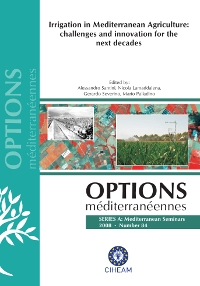| Article précédent | p. 193-201 | Article suivant |
Irrigation strategies to optimise water use efficiency and production in Polygonum tinctorium Ait., a new indigo delivering crop
Today there is increasing interest toward Polygonum tinctorium Ait. (dyer's knotweed) as new crop for indigo production but until now, no research has been carried out on its irrigation requirements. With the aim to assess the crop coefficient (Kc), the seasonal crop water requirement (CWR) and the effects of irrigation on vegetative production and indigo yield, six irrigation levels have been compared in a randomised block design experiment with four replications. The trials have been carried out in Central Italy during two growing seasons characterized by exceptionally rainy (2002) and dry summer conditions (2003) in comparison with the typical ones. Results outlined that the concentration per unit of leaf weight of the indoxyl indigo precursor indican, determined by HPLC-ELSD, was not influenced by irrigation, whereas it was increased by temperatures and light intensity. On the other hand irrigation significantly influenced seasonal plant dry and fresh yield as well as indigo production in both years. Irrigation rates higher than 40 percent ETc did not enhance significantly plant and indigo production. The seasonal CWR recorded from April/May to October 2003, corresponding to 4767 m3 ha-1, was significantly higher (+98 percent) than 2002. Kc values differed significantly with the crop growth stage reaching the maximum value of 0.7-0.8 at full vegetative development when the plants were ready to be harvested for the first time at the beginning of July. The maximum Kc values of 0.5-0.6 were regained at beginning of September before the crop second harvest.
Malgré l'intérêt croissant pour Polygonum tinctorium Ait. qui permet la production d'indigo à grande échelle, aucune recherche n'a encore été réalisée sur ses conditions d'irrigation. Dans le but d'évaluer le coefficient de culture (Kc), les besoins saisonniers en eau (CWR) et les effets de l'irrigation sur la production d'indigo, six niveaux d'irrigation ont été comparés. Les deux années pendant lesquelles ont duré les expérimentations dans le centre de l'Italie, ont été caractérisées par des périodes particulièrement pluvieuses en 2002 et sèches en 2003. Les résultats montrent que contrairement à la température et à l'intensité lumineuse, l'irrigation n'a pas modifié la concentration par unité de poids des feuilles du précurseur d'indigo indican, déterminé par HPLC-ELSD mais l'irrigation a influencé de manière significative le rendement sec et frais ainsi que la production d'indigo. Les niveaux d'irrigation supérieurs à 40 pour cent d'ETc n'ont pas augmenté la production de la plante ni celle d'indigo. Les besoins saisonniers en eau, enregistrés d'avril-mai à octobre 2003, correspondant à 4767 m3 ha-1, étaient sensiblement plus élevés (+ 98 pour cent) qu'en 2002. Les valeurs de Kc ont différé de manière significative pendant l'étape de croissance atteignant la valeur maximale de 0.7-0.8 en plein développement végétatif début juillet. Les valeurs maximum de Kc, de 0.5-0.6, ont été regagnées début septembre avant la deuxième récolte.
- [ Afficher ]
- [ Télécharger ]
- [ Exporter la citation ]
Vous pouvez télécharger la citation au format :
- [ Imprimer ]
-
Mots-clés
BESOIN EN EAU, DOSE D'IRRIGATION, EVAPOTRANSPIRATION, INDIGO, PLANTE TINCTORIALE, RENDEMENT, REPONSE DE LA PLANTECiter cet article
Angelini L.G., Bertolacci M. Irrigation strategies to optimise water use efficiency and production in Polygonum tinctorium Ait., a new indigo delivering crop. In : Santini A. (ed.), Lamaddalena N. (ed.), Severino G. (ed.), Palladino M. (ed.). Irrigation in Mediterranean agriculture: challenges and innovation for the next decades. Bari : CIHEAM, 2008. p. 193-201. (Options Méditerranéennes : Série A. Séminaires Méditerranéens; n. 84). International Conference on Irrigation in Mediterranean Agriculture: Challenges and Innovation for the Next Decades, 2008/06/17-18, Naples (Italy). http://om.ciheam.org/om/pdf/a84/00800966.pdf



